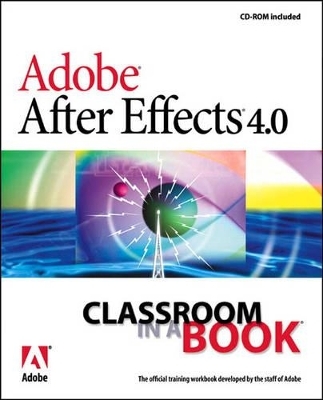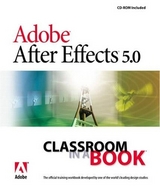
Adobe® After Effects® 4.0 Classroom in a Book
Adobe Press,U.S.
978-0-201-65891-0 (ISBN)
- Titel erscheint in neuer Auflage
- Artikel merken
Adobe After Effects is the tool multimedia professionals turn to for creating animated graphics and visual effects for film, video, and the Web. Adobe After Effects 4.0 Classroom in a Book is the fastest, most comprehensive way to master the program, including Version 4.0's new built-in file format, cross-platform plug-ins, and powerful video and audio special effects such as Wave Warp and Timecode.
Like the other books in the bestselling Classroom in a Book series, Adobe After Effects 4.0 Classroom in a Book teaches the program's tools and techniques in short, focused lessons that you can take at your own pace. For hands-on experience, follow along with the included cross-platform CD and put the techniques to work immediately. Both the book and CD feature material were created and tested by Adobe's software training experts, with illustrations that show you exactly what you should see on-screen.
The Adobe Development Team is made up of creative employees from Adobe's User Education group. They take their expertise in training users to work with Adobe products, combine it with the creative talents of Adobe's product design teams, and add the rich content of the CD-ROM to make a unique learning package from Adobe Systems.
1. Getting Started.
About Classroom in a Book. Prerequisites. Checking system requirements. Installing Adobe After Effects. Using the Classroom in a Book files. Restoring default preferences. Lesson strategies. Rendering QuickTime movies. Special bonus section. Additional resources. Adobe certification.
2. A Quick Tour of Adobe After Effects.
Getting started with your project. Importing footage items. Setting up a composition. Setting layer keyframes. Scaling a layer. Creating a motion path. Synchronizing animation. Applying the Drop Shadow effect. Adding in an adjustment layer. Nesting compositions. Using RAM Preview. Adding and previewing audio. Rendering the project.
3. Getting to Know the Work Area.
Lesson 1. Viewing the final project. Video terminology. Getting started. Project window. Composition window. Time Layout window. Layer switches. Layer properties. Navigating through time. Setting a work area. Previewing the composition. Rendering a movie.
4. Ballet Special Bumper.
Lesson 2. Viewing the final project. Getting started. Size and memory considerations. Using the footage and layer windows. Trimming a layer. Setting a fade-out. Using the Basic Text effect. Duplicating and renaming layers. Copying and pasting keyframes. Magnifying the Time Graph. Animating the opacity. Previewing the animation. A word on space and time. Creating a motion path. Setting Auto-Orient Rotation. Previewing with RAM Preview. Managing the speed of layers. Setting roving keyframes. Using Motion Sketch to create a motion path. Creating a draft movie. Rendering the final movie.
5. Animated L-Train Logo.
Lesson 3. Viewing the final project. Getting started. Size and memory considerations. Setting up the project. Animating the script letter L. Creating masks with the pen tool. Creating a template for a composition. Animating the logo. Positioning the circle. Continuously rasterizing. Nesting Script L Comp. Splitting the comps. Creating the final composition. Applying visual effects. Creating a fade-out composition. Rendering the movie.
6. Multimedia Animation.
Lesson 4. Viewing the final project. Creating the You Dig? movie segment. Getting started. Creating the IDIG movie segment. Creating the Dig It! movie segment. Assembling the final project.
7. Horror Festival Ad.
Viewing the final project. Examining the Photoshop source document. Getting started. Using context menus. Increasing the duration of still images. Using the Time Stretch command. Importing footage with an alpha channel. Preparing video transferred from film. Time stretching the layer. Creating a transition between layers. Creating the ghost by using solids and masks. Animating masks. Using a library to store keyframes. Preparing the audio for an animation. Marking the Audio layer. Matching the ghost mouth to the audio. Using the library of Mask Shape keyframes. Using the Wave Warp effect. Adding the lightning footage. Fine-tuning the audio. Importing an image sequence. Creating a gradient wipe. Time remapping. Creating a fade. Rendering the movie.
8. Station Identification.
Lesson 6. Viewing the final project. Getting started. Size and memory considerations. Animating the background. Animating a masked solid. Copying and pasting keyframes. Changing Spatial Interpolation. Duplicating the layer and keyframes. Animating the moving eyes composition. Creating the pogo stick motion. Creating a squash effect. Setting the interpolation and velocity. Editing the speed graph. Changing the influence. Changing the velocity values. Copying and pasting multiple keyframes. Replacing the artwork. Creating side-to-side motion. Creating the swinging rotation. Nesting the Bounce composition into the Sideways composition. Staggering the animation. Importing a movie. Editing a motion path. Importing the sound. Rendering the final project.
9. Special Effects for Film.
Lesson 7. Viewing the final project. Before you begin. Size and memory considerations. Getting started. Using a process flow. Setting preferences. Using the Timecode effect. Understanding the Cinein file format. Creating a proxy for a high-resolution footage file. Preparing the actor footage. Using color keys. Creating the Handlight Composition. Positioning the elements for the final composition. Using the Motion Tracker Keyframe assistant. Positioning the CD-ROM image. Finishing the composition. Creating the final composition. Rendering the project.
10. Technical Information.
Frame rate issue. Video safe zones. NTSC color space. Video aspect ratios. Interlace issues. Video transfer issues. Rendering for film. Audio issues.
Index.
Project designers.
| Erscheint lt. Verlag | 1.11.1999 |
|---|---|
| Verlagsort | Indianapolis |
| Sprache | englisch |
| Maße | 188 x 232 mm |
| Gewicht | 785 g |
| Themenwelt | Mathematik / Informatik ► Informatik ► Grafik / Design |
| Mathematik / Informatik ► Informatik ► Theorie / Studium | |
| ISBN-10 | 0-201-65891-7 / 0201658917 |
| ISBN-13 | 978-0-201-65891-0 / 9780201658910 |
| Zustand | Neuware |
| Haben Sie eine Frage zum Produkt? |
